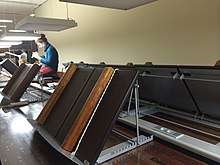Royal Library of Belgium
The Royal Library of Belgium (French: Bibliothèque royale de Belgique, Dutch: Koninklijke Bibliotheek van België, abbreviated KBR and sometimes nicknamed Albertine in French or Albertina in Dutch) is the national library of Belgium. The library has a history that goes back to the age of the Dukes of Burgundy. In the second half of the 20th century, a new building was constructed on the Mont des Arts in central Brussels, near the Central Station. The library owns several collections of historical importance, like the famous Fétis archives, and is the depository for all books ever published in Belgium or abroad by Belgian authors.
| Koninklijke Bibliotheek van België Bibliothèque royale de Belgique | |
 | |
 The Royal Library and the equestrian statue of King Albert I | |
| Country | Belgium |
|---|---|
| Type | National library |
| Established | 1837 |
| Location | Boulevard de l'Empereur/Keizerslaan 4 City of Brussels, Brussels-Capital Region |
| Collection | |
| Size | 6 million volumes |
| Legal deposit | Yes |
| Website | Official website |
| Map | |

| |
There are four million bound volumes in the Royal Library, including a rare book collection numbering 45,000 works. The library has more than 700,000 engravings and drawings, 150,000 maps and plans, and more than 250,000 objects, from coins to scales to monetary weights. This coin collection holds one of the most valuable coins in the field of numismatics, a fifth-century Sicilian tetradrachm.[1] The library also houses the Center for American Studies, a rich American Studies collection of 30,000 books in open stacks, as well as U.S. newspapers and databases.[2]
The Royal Library is open for reference only. Patrons must be at least eighteen years of age and must pay an annual membership fee.[3]
Collection
_-_KBR_27-8-2016_11-33-21.jpg)
With more than 6 million books (more than 150 kilometres of bookshelves), the Royal Library of Belgium is the biggest library in the country. It contains:
- 4,000,000 books
- 21,500 magazines
- 150,000 maps
- 32,000 manuscripts
- 300,000 ancient printed materials
- 700,000 pictures
- 9,200 microfilms
- 50,000 long playing records
The library has 6 “special” divisions, namely the precious works, maps and plans, sheet music, manuscripts, coins, and medals. It also serves as a collection point of Dutch-language artworks. The initial basis of the collections were the library of Charles van Hulthem, acquired in 1837, and the library of the City of Brussels, acquired in 1842, which had come to include large parts of the former Royal Library of the Low Countries (founded 1559).
Important funds
Made up of around 60 smaller collections concerning music, the music department is a significant resource for the study of music history in Belgium and abroad. The most representative pieces are part of collections of François-Joseph Fétis, Eugène Ysaÿe, Henri Vieuxtemps, Marc Danval, Yves Becko,[4] Denijs Dille, Flor Peeters or also Edgar Tinel.[5]
Music Division

The Royal Library of Belgium's Music Division is considered one of Belgium's most important centers for the preservation and study of music-related documents. The Music Division maintains a rich and varied collection composed of hundreds of thousands of manuscript and printed scores, about 100,000 sound recordings, a large collection of correspondence, printed works, concert programmes, posters, photographs and other iconographic documents, not to mention varied objects such as medals, busts, casts, music instruments. Although most music-related documents in the Royal Library are held in the Music Division, certain additional works are held in the Manuscript, Rare Books and Prints and Engravings divisions of the Library.
The Music Division was founded in 1965, building upon the more than 5,000 printed and manuscript documents that made up the private collection of the important 19th century Belgian musicologist François-Joseph Fétis, acquired by the Royal Library in 1872. This Fétis Collection is an important source for the study of early music, and holds a number of important documents such as the autograph manuscript of Johann Sebastian Bach's BWV 995 – Suite in G minor.[6] Among the oldest pieces of the Fétis Collection are several late 15th century manuscripts by theorist Johannes Tinctoris.
The Music Division maintains an active policy of acquisitions through donations and purchase of documents linked with Belgian musical figures such as André-Ernest-Modeste Grétry, Henri Vieuxtemps, César Franck, Eugène Ysaÿe and Guillaume Lekeu, not to mention other European figures such as Albert Roussel, Darius Milhaud, Franz Liszt, Béla Bartók and Edvard Grieg. More recently, the purchase of the Marc Danval and Eric Mathot collections enriched the Music Division's collections with tens of thousands recordings and scores of jazz, salon and other popular music from Belgium and abroad.
Through legal deposit, the Music Division also acquires a considerable number of musicological works and scores printed in Belgium. The Music Division assumes an active role within various international associations, notably IAML, RILM and RISM.
The non-profit organization Archives Béla Bartók de Belgique was created in 2002 and has its headquarters in the Music Division.
The Librarium of the Royal Library of Belgium
The Librarium is a permanent exhibition dedicated to the history of books. The Librarium consists of 6 halls each shedding a different light on carriers of writing. In the first hall the book emergence is introduced. The whole room is dedicated to show the relation between word and image. The collection material is changed every three months. Moreover, the exhibition shows furnished rooms of Henry van de Velde, Michel de Ghelderode and Émile Verhaeren.
Directors
- 1837–1850: Frédéric de Reiffenberg
- 1850–1887: Louis-Joseph Alvin
- 1887–1904: Edouard Fétis
- 1904–1909: Henri Hymans
- 1909–1912: Joseph Van den Gheyn, S.J.
- 1912–1914: Dom Ursmer Berlière O.S.B.
- 1919–1929: Louis Paris
- 1929–1943: Victor Tourneur
- 1944–1953: Frédéric Lyna
- 1953–1955: Marcel Hoc
- 1956–1973: Herman Liebaers
- 1973–1990: Martin Wittek
- 1990–1991: Denise De Weerdt
- 1992: Josiane Roelants-Abraham
- 1992–2002: Pierre Cockshaw
- 2002–2005: Raphaël De Smedt
- 2005–2017: Patrick Lefèvre
- 2017–present: Sara Lammens
See also
- List of libraries in Belgium
- Academia Belgica
- Belgian Federal Science Policy Office (BELSPO)
- Brussels Coin Cabinet
- Center for Historical Research and Documentation on War and Contemporary Society
- National and Provincial State Archives
- National Library of the Netherlands
References
- Murray, Stuart A. P. The Library: An Illustrated History. New York: Skyhorse Publishing, 2012, p. 249-250.
- http://www.kbr.be/en/cas
- Murray, Stuart A. P. The Library: An Illustrated History. New York: Skyhorse Publishing, 2012, p. 250.
- Opera.be : la collection Yves Becko / F. Lemmers (ed.) - ISBN 9782872124992
- Edgar Tinel (1854-1912) : een levensschets [exhibition catalogue ] / N. Verstraeten (ed.) - ISBN 9066371293
- Digital library of the Royal Library of Belgium - Collections - Music: Johann Sebastian Bach, Suite for lute
External links
| Wikimedia Commons has media related to Koninklijke Bibliotheek/Bibliothèque Royale. |
- Official website (in Dutch and French)
- Official Website of the Center for American Studies (in English)
- Floorplan of the Library